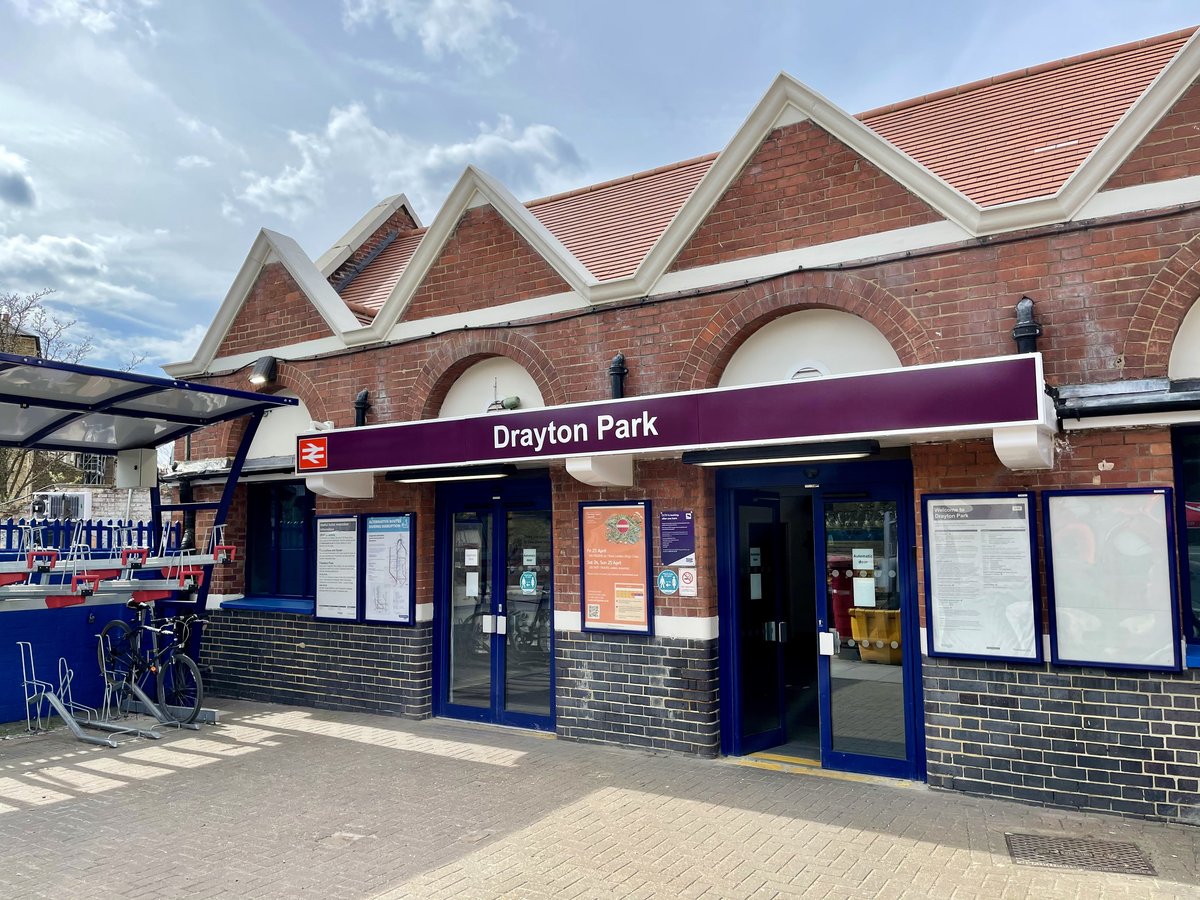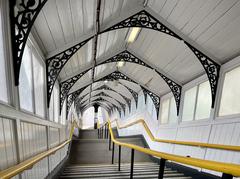
Drayton Park Railway Station: Visiting Hours, Tickets, and Travel Guide
Date: 15/06/2025
Introduction
Drayton Park Railway Station, located in the heart of Highbury within the London Borough of Islington, is a distinctive node in the city’s transport network. Since its opening in 1904 as part of the Great Northern & City Railway, this station has played an essential role in linking central London to its northern suburbs, while also bearing witness to over a century of change in the city’s industrial and residential landscape (RailMapOnline; Angry of Islington). Its proximity to the Emirates Stadium and position on the Northern City Line have cemented its importance as a commuter hub, a cultural touchstone, and a vital gateway for football fans and visitors alike.
This detailed guide explores Drayton Park’s history, architectural evolution, community significance, and provides practical information on opening hours, ticketing, accessibility, and travel tips. It is designed for both daily users and tourists seeking to explore London’s railway heritage and vibrant local culture (TfL Drayton Park; National Rail).
Table of Contents
- Introduction
- Historical Development
- Architecture and Community Role
- Service Patterns and Modernization
- Impact of Emirates Stadium
- Visiting Drayton Park: Practical Information
- Nearby Attractions
- Special Event Arrangements
- Frequently Asked Questions (FAQ)
- Conclusion
- References
Historical Development
Origins and Growth
Opened in 1904, Drayton Park was part of the ambitious Great Northern & City Railway (GN&CR), intended to provide mainline trains with direct underground access to the City of London (RailMapOnline; Angry of Islington). The station was strategically sited in a largely undeveloped area, minimizing disruption and facilitating construction. Initially, it served both passengers and local industries, with sidings connecting to a coal depot, an “Electric Light Station,” and other municipal facilities.
Evolution and Integration
Over time, Drayton Park’s function changed as railway lines were nationalized and integrated into the London Underground and British Rail networks. The line’s transition from the Metropolitan Railway to the London & North Eastern Railway (LNER), and eventually British Railways, reflected broader shifts in London’s rail infrastructure. In the late 1970s, the Drayton Park to Moorgate section was electrified and incorporated into suburban rail services, prompting modernization and platform upgrades (RailwayData).
Architecture and Community Role
Architectural Features
The station’s original design was utilitarian, reflecting early 20th-century railway priorities. Over the decades, functional upgrades have maintained its practical character, while periodic refurbishments introduced improvements for passenger comfort and accessibility. Despite modernization, Drayton Park retains distinctive historical features such as its track cutting and location near legacy railway infrastructure (RailMapOnline).
Community Impact
Drayton Park has long served as a local landmark and gathering point. In its early years, it anchored a community of industrial workers and residents, with establishments like the Drayton Park Hotel providing social spaces (Angry of Islington). Its evolution mirrors the area’s transformation from industrial hub to a blend of residential, commercial, and sporting activity.
Service Patterns and Modernization
Changing Services
Originally conceived for mainline operation, the line’s technical challenges necessitated adaptation for electric suburban trains. Off-peak services are now frequent and reliable, operated by Great Northern using Class 717 Electric Multiple Units (EMUs). Drayton Park is fully integrated into the Oyster/contactless payment system, with real-time service information available for seamless travel (TfL Journey Planner).
Accessibility
Recent upgrades have improved station accessibility, including step-free entry and tactile paving, though some limitations remain. Assistance is available upon request, and travelers with mobility needs are advised to check accessibility details before visiting (South Western Railway).
Impact of Emirates Stadium
The construction of the Emirates Stadium in 2006 brought significant change, turning Drayton Park into a crucial access point for Arsenal FC supporters (Angry of Islington). On match days, the station experiences high passenger volumes, leading to special service arrangements and temporary closures for crowd control and safety (Arsenal FC Local Residents News). The surrounding area becomes a hive of activity, with fans, vendors, and local businesses contributing to the lively atmosphere.
Visiting Drayton Park: Practical Information
Opening Hours
- Regular Days: Drayton Park operates early morning to late evening, in line with Northern City Line train schedules.
- Match/Event Days: The station may close before and after Arsenal matches or major events for safety reasons. Always confirm hours via official sources before traveling (TfL Drayton Park; Arsenal FC Local Residents News).
Ticketing
- Purchase: Tickets are available from self-service machines, which also support Oyster top-ups and railcard discounts.
- Payment: Oyster cards, contactless payment, and Travelcards are accepted. Note that Oyster cards cannot be purchased at the station itself (South Western Railway).
- Advance Tickets: Recommended for visitors, especially during busy periods.
Accessibility
- Step-Free Access: Step-free access is available from street to platform, though some limitations remain; assistance is available upon request (South Western Railway).
- Support: Help points and an Assistance Meeting Point are provided; arrive early if assistance is required.
Facilities
- Waiting Areas: Unheated shelters and seating on platforms.
- Amenities: No public restrooms, shops, or cash machines at the station; local amenities are available nearby on Holloway Road and around Emirates Stadium.
Travel Tips
- Travelcard Zone: Drayton Park is in Zone 2, enabling easy connection to central and north London.
- Bicycle Storage: Cycle racks are provided at the entrance.
- Parking: No station car park; public transport is recommended.
- Bus Connections: Local routes serve the area; check TfL for details.
Nearby Attractions
- Emirates Stadium: Home of Arsenal FC; stadium tours and museum available (official Arsenal website).
- Highbury Fields: Historic park nearby, ideal for walks.
- Holloway Road & Upper Street: Shops, cafes, pubs, and restaurants reflecting the area’s diverse culture.
- Arsenal Museum: Explore the club’s history on non-match days.
Special Event Arrangements
On Arsenal match days and major events:
- Drayton Park station closes for safety before and after games.
- Alternative stations: Highbury & Islington, Finsbury Park, or Arsenal (Piccadilly Line).
- Expect local road closures and parking restrictions; plan ahead (Arsenal FC Local Residents News).
Frequently Asked Questions (FAQ)
Q: What are Drayton Park station’s opening hours?
A: Early morning to late evening, but subject to closure during major events. Always check current schedules before travel.
Q: How do I buy tickets?
A: Use self-service machines for tickets and Oyster top-ups. Oyster cards must be purchased elsewhere.
Q: Is Drayton Park accessible for wheelchair users?
A: Step-free access is available, but some mobility limitations remain. Assistance can be arranged in advance.
Q: What should I do on Arsenal match days?
A: Drayton Park is closed before and after matches. Use Highbury & Islington or Finsbury Park stations instead.
Q: What attractions are nearby?
A: Emirates Stadium, Highbury Fields, local shops and pubs on Holloway Road and Upper Street.
Conclusion
Drayton Park Railway Station is a unique combination of historical legacy and modern-day function. Its evolution from industrial outpost to essential commuter hub and match day gateway reflects the broader story of London’s railway and urban development. Visitors can enjoy efficient rail links, immerse themselves in local history, and experience the vibrant community spirit, particularly on event days.
For up-to-date travel information, ticket bookings, and additional guides, download the Audiala app and follow our social media channels.
References
- RailMapOnline
- Angry of Islington
- RailwayData
- TfL Drayton Park
- National Rail
- South Western Railway
- TfL Journey Planner
- Arsenal FC Local Residents News
- official Arsenal website





















































































































































































































































